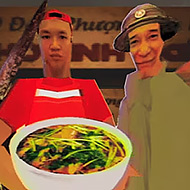Pikabuu: STOP invites players into an intimate and emotional journey, unfolding within the confines of a quiet home filled with tension and regret. You step into the shoes of Beni, a husband and father burdened by the consequences of a single, life-changing mistake. This narrative-driven experience is less about gameplay mechanics and more about exploring the fragile dynamics of a family struggling to cope with the aftermath.
Immersive Emotional Storytelling
Unlike traditional games that focus on action or puzzles, Pikabuu: STOP centers entirely on mood and narrative. The story is revealed through sparse, carefully crafted dialogues and the atmosphere of the environment. The strained relationship between Beni, his wife Nadia, and their daughter Kaila becomes clear through subtle interactions, pauses, and the weight of what remains unspoken. This creates a hauntingly realistic portrayal of guilt and emotional distance.
• Characters that feel real: Each conversation reflects the complex feelings of love, regret, and frustration.
• Minimalist narrative: The story unfolds through implication rather than explicit explanation.
• Emotional tension: Every room and interaction is charged with meaning and consequence
Simple Controls, Deep Experience
The gameplay is deliberately simple to ensure the story takes center stage. Movement is controlled with the WASD keys, allowing you to navigate the different rooms of the house. The Spacebar progresses dialogue, while pressing E interacts with important objects that unlock additional layers of the narrative. Shift allows you to run during rare moments of emotional urgency, reinforcing the game’s connection between movement and internal state.
• WASD: Move Beni through the familiar yet emotionally changed home.
• Space: Advance conversations and internal thoughts.
• E: Inspect objects that trigger memories and reveal hidden feelings.
• Shift: Sprint through moments of high tension.
Atmosphere That Speaks Volumes
The game’s art style is intentionally understated, using muted colors and minimal animations to emphasize the emotional weight rather than visual spectacle. Hand-drawn character portraits convey subtle expressions, while the quiet soundscape—soft footsteps, distant creaks, and ambient noise—adds to the atmosphere of unease and reflection. This simplicity invites players to focus on the narrative and the psychological state of the characters.
• Muted palette: Colors reflect the somber mood and emotional strain.
• Static portraits: Faces reveal inner turmoil with minimal movement.
• Sound design: Sparse audio enhances immersion without distraction.
Why Pikabuu: STOP Resonates
Pikabuu: STOP is a game that doesn’t rely on fast-paced action or complex mechanics. Instead, it offers a deeply personal and emotional narrative experience. It explores themes of regret, broken trust, and the difficulty of reconciliation with honesty and sensitivity. The game lingers in the mind, inviting players to reflect on the consequences of their choices and the fragility of human relationships.
For players seeking a story that is as much about silence and subtext as dialogue and decision, Pikabuu: STOP delivers a memorable, heartfelt journey that stays with you long after the final scene.













 Fullscreen
Fullscreen


